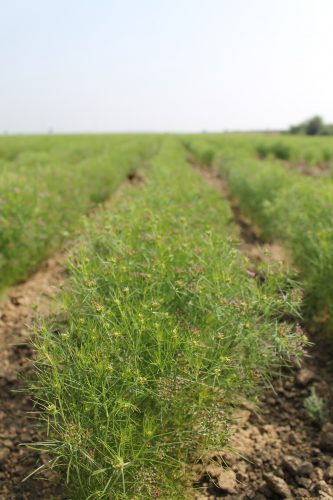Determining ingredient authenticity
- Like
- Digg
- Del
- Tumblr
- VKontakte
- Buffer
- Love This
- Odnoklassniki
- Meneame
- Blogger
- Amazon
- Yahoo Mail
- Gmail
- AOL
- Newsvine
- HackerNews
- Evernote
- MySpace
- Mail.ru
- Viadeo
- Line
- Comments
- Yummly
- SMS
- Viber
- Telegram
- Subscribe
- Skype
- Facebook Messenger
- Kakao
- LiveJournal
- Yammer
- Edgar
- Fintel
- Mix
- Instapaper
- Copy Link
Posted: 25 February 2020 | Gideon Ashworth | No comments yet
Ahead of his presentation at Food Integrity 2020, Bart Ingredients’ Head of Food Defence, Gideon Ashworth, outlines the company’s approach to ensuring authenticity of ingredients across the supply chain.


There is much historical evidence of ingredient authenticity being compromised by unscrupulous criminals tempted by ill-gotten financial gains. Indeed, such was the seriousness of such practices that 14th century Nuremburg’s ‘Safranschou Code’ decreed that saffron adulteration be punishable by death.
While 21st-century citizens do not condone such radical deterrent methods, we benefit from logical approaches to technical supply chain management, combined with the increasing focus on developing detection methods. These technological advances also act as deterrents in themselves from the temptation of economically motivated fraudulent activities.
Bart Ingredients’ supply base covers a range of ingredient categories from IQF (individually quick frozen) fruit, through to vinegars and cooking oils. Our heritage, however, is in culinary dried herbs and spices, and we continue to thrive and flourish at the forefront of this category. Dried herbs and spices are widely considered to be at risk of deliberate Economically Motivated Adulteration (EMA); for example, recent incidents of EMA involving saffron and oregano have been reported in the mainstream news. Some recent articles and publications elude to lengthy and complex supply chains catalysing the problem. It is of note that the ‘length’ and ‘complexity’ aspects are seldom referred to with definition. While the length (or number of handling points) of supply chains may increase the intensity of vulnerability scrutiny required, the assumption that the more desirable, less complex ‘short’ chains eliminate food fraud risk does not always ring true. Furthermore, a shorter supply chain may not always be practicably or commercially achievable.
Understanding the parametric variables within products is critical in selecting the most eligible detection method.
The criticalities sit within the visibility of a supply chain; with clarity ranging from opaque, through translucent to transparent, enabling detailed vulnerability assessments and increased confidence in ingredient authenticity.
Some companies in the industry process widely different products under the same process technique; however, the Bart business model allows flexibility to source the highest quality ingredients from specialists in their given product area. Being packers rather than processors, our mitigation strategies factor in all points along the supply chains that fall outside of our own factory controls.


A lengthy supply chain has been pinpointed by many as the main reason why spices, such as cumin (pictured), are at such risk of adulteration
Design and implementation of a food fraud mitigation strategy that protects the integrity of a company’s products, brands and wider category listings should be tailored to that particular business. There is no one-size-fits-all strategy. However, there are different elements of risk to consider when assessing potential for adulteration to ingredients along the supply chain: VACCP (Vulnerability Assessment Critical Control Points) is an accepted model used for the risk assessment of EMA. TACCP (Threat Assessment and Critical Control Points) is a model applied for the mitigation of ideologically motivated malicious contamination of ingredients. Implementation of the two risk assessment models, alongside company or product-specific controls make up the Food Defence Protocols.
The following article offers an insight into the Bart Ingredients Food Defence approach, which will be presented in finer detail at the Food Integrity 2020 event (www.foodintegrityevent.com) in March.
Mitigation strategies
Bart Ingredients take a balanced approach to ingredient integrity management, blending mitigation strategies with methods of authenticity verification. Bart Food Defence protocols around technical supply chain management commence at the Supplier Selection and Product Approval stage (plan), with food fraud mitigation being a major driver within the wider scope of risk consideration.
The process encourages clear visibility over all supply chain points of handling, rather than an automatic rejection of ‘complex’ supply chains.
Each product carries its own risk rating, deciphered from multiple sources of information and data sets. Ingredients are approved and risk assessed individually as they require potentially varied controls and differing degrees of emphasis on specific analytes at intake testing. Material equivalency is applied when benchmarking an existing product for ingredient approval. This involves an in-depth organoleptic assessment and discrepancy evaluation of supplier paperwork, including specifications, vulnerability assessments and a gauge of the agricultural practices and postharvest processes.
The process encourages clear visibility over all supply chain points of handling, rather than an automatic rejection of ‘complex’ supply chains. This results in increased product intelligence, culminating in widespread product and supply‑chain knowledge across various departments within the company. Mutually agreed raw material specifications define individual ingredient expectation and acceptance criteria between both parties for trading to commence (do).
Ongoing supplier management drives trend analysis of results and overall supplier OTIFIC (on time, in full, invoiced correctly) performance (review). Emphasis on relationship building is encouraged throughout a supply chain structure, with alignment of expectations being fundamental to technical supply chain management. Risk mitigation can be increased in line with emerging hazards, as highlighted in the Bart Ingredients weekly alert bulletin, derived from 35 sources and shared with relevant stakeholders in our supply and distribution chains. Bart Ingredients’ audit schedule captures suppliers on rotation, determined by risk-based necessity. The cost-to-value benefit of audit budgeting should not be scrimped on.
Supplier audits should not only cover HACCP food safety scrutiny and factory inspections, but also facilitate assessment of multiple capabilities from agricultural practices in the field and onwards through the supply chain. A well-rounded audit should have a strongly weighted emphasis on transparency, ethics and relationships, which are all too often overlooked in the audit process. The overall approach results in Bart Ingredients selecting expert suppliers for their respective ingredients, combined with transparency over each supply chain.
Gideon Ashworth will be speaking at Food Integrity 2020. To find out more about his contributions and about the event as a whole, click here to find the agenda and speaker list.
Methods implemented to verify ingredient authenticity
Bart Ingredients work with experts from a range of laboratories and research institutes, who offer prompt and detailed updates on evolving and emerging technologies and methodologies, affording the company insights to the latest method developments.
Differing analytical methods are not applicable to all food categories; for example, Next Generation Sequencing (NGS) is more suited to meat and fish DNA verification than dried herbs and spices. Understanding the parametric variables within products is critical in selecting the most eligible detection method. Dried herbs and spices are subject to widely variable processing techniques; time and temperature applications can be altered to the minutest of increments by the experienced operator in order to achieve consistent levels of safety and quality. Despite falling within the scope of HACCP critical limits, even minor alterations can damage the plant DNA or alter the chemical bonds compared with previous batches, rendering some detection methods unsuitable for practical application.
Bart Ingredients are early adopters of a Near Infrared (NIR) spectrometer for ingredient authenticity verification. NIR spectroscopy reveals the ‘chemical fingerprint’ of the food product by measuring the amount of near infrared energy absorbed by the target sample at defined wavelengths.
Implementing an NIR spectrometer into a commercial environment does not come without its challenges, especially in terms of initial setup costs and resource time management. Bart Ingredients’ NIR spectroscopy work is planned to be ongoing in its nature as datasets continue to grow across its wide ingredients range. Each batch is sampled at intake to Bart Ingredients.


Dried herbs and spices are considered to be commodities at particular risk of deliberate Economically Motivated Adulteration
It is placed on the instrument, which rapidly (within 60 seconds) takes 32 scans of the sample and can offer a pass/fail judgement on the authenticity of the sample material. The technology has the capability to detect known adulterants that have been scanned into the database and, furthermore, it can detect ‘unknown unknowns’ within a given sample.
Contrary to the notion that the technology is implemented solely to detect fraudulent practices, it also demonstrates verification of ingredient authenticity in well-managed, trusted supply chains. The non-targeted method is non-destructive, meaning the sample can be sent for confirmatory analysis should result discrepancy present itself, or for actively challenging the instrument’s capabilities against other methods, such as microscopy. The efficacy of microscopy is respected and is the ASTA-recommended method for oregano authenticity verification.
The advantages of in-house NIR spectroscopy are readily demonstrable. The technology offers verification of Bart Food Defence protocols within technical supply chain management and, therefore, transfers confidence to our onward customers. Given the media and industry attention on herb and spice authenticity, implementing the technology offers protection from negative hype. The technology’s sensitivity is demonstrated by variation in sample fingerprints, caused by multiple factors such as differing species, varietal differences, country of origin and moisture differences. The implementation project has, thus far, generated some interesting side projects for the team, while encouraging the ethos of continuous learning and development.
There are many other methods of detection not mentioned in this article that require in-depth discussion, rather than being placed on a list. Current development includes Polymerase Chain Reaction (PCR), which isolates a single DNA sample and replicates to the millions, giving interpretable results. The method for dried herbs and spices continues to be developed by research institutions, including Campden BRI, with emphasis on numbers of amplicons in the method focusing on ingredients with known high vulnerability to EMA, notably oregano.
Conclusion
Determining ingredient authenticity along supply chains requires a balanced approach between strategic food defence protocols and the adoption of detection methods that suit the given product. This article focused on authenticity of dried herbs and spices, therefore has not included all detection methods available.
A wider industry discussion to challenge the definition of supply chain ‘length and complexity’ could help with determining risk levels along supply chains; perhaps in some instances ‘complexity’ and ‘misunderstanding’ are one in the same. Bart Ingredients’ experience to date is that longer supply chains do not necessarily equate to an elevated food fraud risk. Supplier selection, transparency over individual ingredient supply chains, ingredient integrity verification at intake and regular review with scrutiny is the balanced approach to ingredient integrity management.
About the author
Gideon Ashworth is Head of Food Defence at Bart Ingredients. He has extensive experience in primary food production and technical management, including the challenges of emerging ingredients and their associated emerging hazards. With a background in Commercial Horticulture and an MSc in Postharvest Technology, Gideon’s applied technical knowledge of global food supply chains underpins his approach to food authenticity verification. Among current projects for Bart Ingredients, he is involved in the implementation of NIR spectroscopy technology within the commercial environment, with an emphasis on herbs and spices.
Issue
Related topics
Food Safety, Health & Nutrition, Ingredients, Regulation & Legislation, Supply chain










